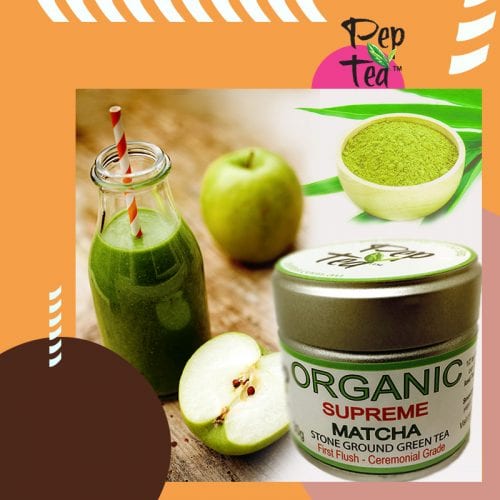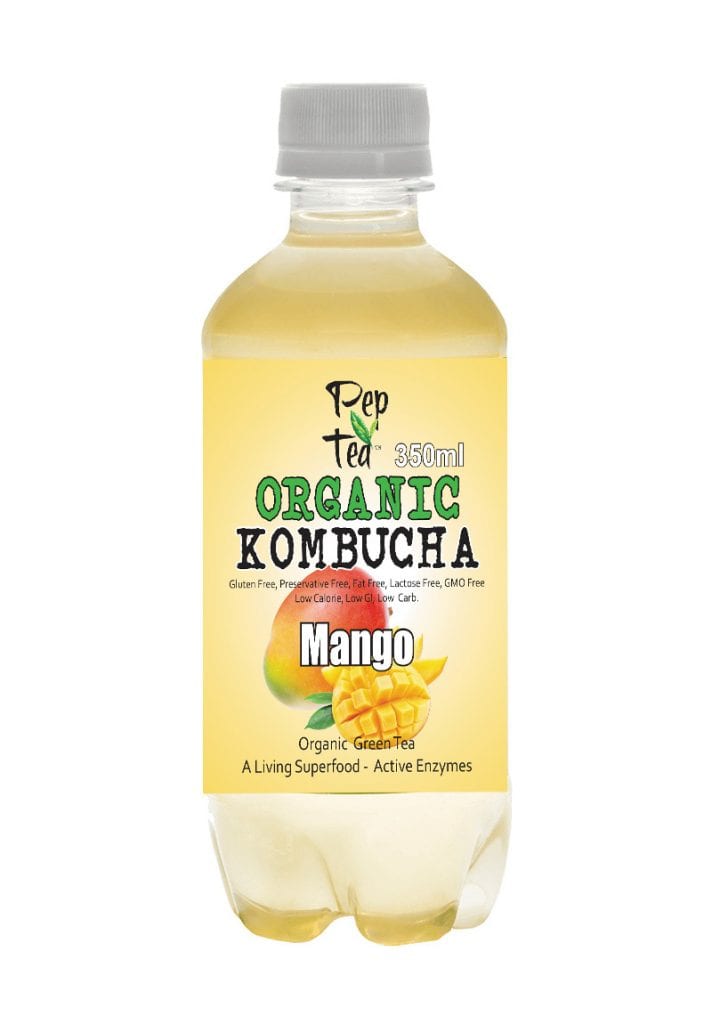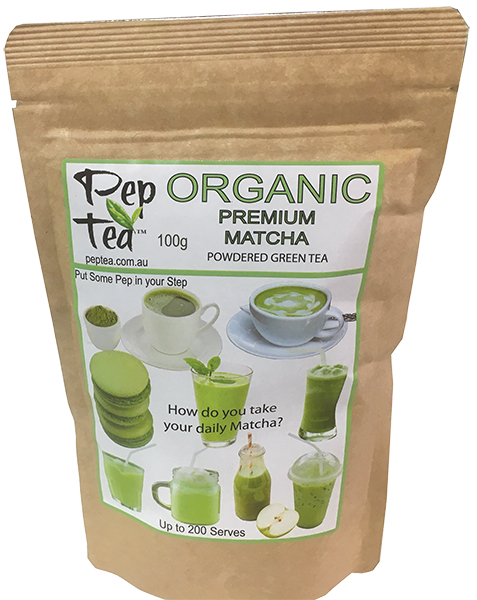Category: Learn About Tea
How Many Cups of Matcha Tea Powder are Safe Per Day?

Matcha is a type of green tea which is grown in the famous tea plantations of Japan and also in China. The drinking of powdered green tea leaves for heath reasons became a ceremonial tradition which was practiced in Japan. Over the centuries the tradition is still being continued in Japan whereas in China it had slowly lost some its importance until recent years. Where ceremonies were held the High grade matcha tea is made and served according to the auspicious rituals of the Japanese tea ceremony.
Pep Tea a leading brand of Kombucha and Matcha was established with the vision to bring the old tradition of Matcha tea to Australia. Besides the authentic traditional facts they also provide amazing benefits to our body.
Caffeine in Matcha
Like coffee, matcha contains caffeine, but instead of the jitters it gives you a clean high. A matcha tea provides more caffeine than black tea around the same as a cup of brewed coffee but less than the amount of an espresso, however, the tea’s buzz is much more energising and longer-lasting
It depends on how strong you drink it of course but on average Matcha tea contains on average around 70mg of caffeine for an 8 ounce cup. Whereas black tea contains, on average, around 55 mg of caffeine per 8 ounces, and coffee contains around 100 mg. Interestingly, green tea also contains the amino acid L-theanine.
Caffeine is usually thought to be safe in moderate amounts. Experts consider 200–300 mg of caffeine a day to be a moderate amount for adults. So a moderate dose of caffeine through drinking Matcha tea is about 3 cups per day.
Consuming Matcha tea on a daily basis increases the antioxidant compounds in our body which can protect us from heart disease, diabetes, cancer, and dementia. Whereas you should also be careful about the amount of Matcha consumption you take as overdose of caffeine can leads to side effect. To make one cup of Matcha Tea you should use 1/2 teaspoon of Matcha Powder as one cup of Matcha green tea is equivalent to 10 cups of ordinary Green Tea. So Generally it is though that if you consume Matcha Tea on a daily basis you should probably not have more than 5 cups a day. If you keep these things in check then the Matcha Tea is capable to keep you energized throughout the day and give you great health benefits.
Order high-grade Matcha powder wholesale from our online store. Pep Tea is a trademarked brand of Opera Foods who deliver products overnight to most postcodes in Australia.
How to Distinguish Between Ordinary and Ultimate Matcha Tea Powder?

Though Matcha has originated in Japan and China it has recently gained popularity in Australia. Organic Matcha Tea has become the most loved tea among various other Green Tea because of its amazing health benefits.
High Grade Matchan ot only tastes a little sweeter but it also makes you feel better before you start your day. But you have to be cautious when you are buying the Matcha green tea powder; you have to notice several factors like it’s Colour, Price, and Benefits. If it has a vibrant green colour it means the leaves have been the first crop of the season grown in shade to have maximum chlorophyll content. On the other hand, if it has a browner colour it means they are from a later season harvest and contains less chlorophyll.
Buy the best Matcha Tea powder from Peptea and if you want Organic Matcha wholesale you can order from our wholesale supplier Opera Foods.
Foods to fight Cancer- Matcha Tea

Ceremonial grade Matcha Tea, if is organically grown, is one of the best foods to fight cancer. It is very high in antioxidants because it uses the whole of the tea leaf. These leaves are picked from the first flush of fresh tiny leaves, which is shade grown, and then stone ground into a very fine powder.
Foods to fight Cancer- Matcha Tea
Not all antioxidants are created equal. Green tea contains a specific set of organic compounds known as catechins. Among antioxidants, catechins are the most potent and beneficial. One specific catechin called epigallocatechin gallate (EGCg) makes up 60% of the catechins in Matcha Green Tea. Out of all the antioxidants, EGCg is the most widely recognized for its cancer fighting properties.
Brewed Green tea is particularly rich in EGCg compounds, with about four times more EGCg than black tea. However Ceremonial grade Japanese Matcha Green Tea contains around 3 times more EGCg than tradition brewed green tea. So high quality Matcha teas are Foods to fight Cancer .
Drink it daily, if you want a food to fight cancer, but do choose a Match tea powder that is Certified Organic and 100% Japanese and then only ceremonial grade from the first flush crop of the season, from the famous southern Japanese tea plantations.
NB: (Many Matcha tea products are blended with late season inferior crops, or milled in metal grinders that are not as finely ground or most often even blended with cheap Chinese Matcha teas that are not grown & processed under the same health standards. Read how to recognise the grade and quality of Match Tea at www.peptea.com.au)
The Story of Tea
Tea is a universally popular and quite aromatic beverage most often prepared by steeping or soaking in boiled water the cured, dried, oxidised, fermented, or ground, leaves of the Camellia Sinensis tree, an evergreen bush native to East Asia. Apart from water, tea is the most popular drink for humans.
The Tea plant is native to the borderlands of north Burma and southwest China. The habit of drinking tea is believed to have started during the Shang Dynasty in in the Yunnan region of China, where it was taken for medicinal purposes.
Later it is thought that Sichuan, residents began to boil tea leaves for consumption into a concentrated liquid without the addition of other leaves or herbs, and so started using tea as a stimulating drink, as opposed to purely as a medicinal treatment.
Two principal varieties of the tea plant are grown in plantations for tea beverages: Camellia sinensis is used for most Chinese and Japanese teas, and a sub-species, Camellia assamica, is used in most Indian teas (except Darjeeling which uses the original Camellia sinensis).
Within these two botanical tea varieties, many strains and varieties of tea exist. Leaf size is the main basis for the classification of tea plants, with the three key classifications being; China type, characterised by the smallest leaves; Assam type, characterised by the largest leaves; and a Cambodian type, characterised by medium sized leaves.
Many different types of tea have evolved by varying degrees and methods of treatment of the tea leaves; some teas, such as Chinese green teas, and Darjeeling have a slightly bitter, and astringent flavour, while other teas have quite different profiles including sweet, nutty, floral or grassy.
During the centuries, a variety of different techniques for processing tea leaves, and a range of different forms of tea, were developed. In the Tang dynasty, tea was steamed, then pounded and shaped into cake form, while in the Song dynasty, loose-leaf tea was developed and became popular. During the Yuan and Ming dynasties, unoxidized tea leaves were first pan-fried, then rolled and dried, a process that stops the oxidation process that turns the leaves dark, thereby allowing tea to remain green. In the 15th century, oolong tea, in which the leaves were allowed to partially oxidize before pan-frying, was developed. Western tastes, later, favoured the fully oxidized black tea, and so the leaves were allowed to oxidize further. Yellow tea was an accidental discovery in the production of green tea during the Ming dynasty, when apparently poor control practices allowed the leaves to turn yellow, but yielded a different flavour as a result.
Green tea was known as the “healthiest” form of tea due to its lack of processing, resulting in extremely high nutrient levels. However the ancient Buddhist monks in Japan went one better with Matcha Tea, by grinding the leaves to a powder and because the entire leaf is ingested in a powder form, it is the most potent green tea available.
In Japanese “cha” means tea, and “ma” means powder, thus the word matcha translates literally as powdered green tea. It is believed that the very first green tea seeds were brought to Japan from China by Eisai (1141-1215), the founder of the Rinzai sect of Zen Buddhism, in 1191 A.D., who planted them on the temple grounds in Kyoto. Eisai encouraged the cultivation of tea trees, and his Kissa yojoki (Health Benefits of Tea), tied tea-drinking to longevity and launched tea in Japan on a large scale.
Kombucha Tea is a living health drink made by fermenting tea and sugar with the kombucha culture. The resulting brew can taste like something between sparkling apple cider and champagne, depending on what type of tea you use. It’s not what you’d imagine fermented tea to taste like.
The exact origins of Kombucha Tea have become lost in the mists of time. It is thought to have originated in the Far East, probably China, and has been consumed there for at least two thousand years. The first recorded use of kombucha comes from China in 221 BC during the Tsin Dynasty. It was known as “The Tea of Immortality”
Masala Chai Tea is a flavoured tea beverage made by brewing black tea with a mixture of aromatic Indian spices, and herbs. Originating in India, the beverage has gained worldwide popularity, becoming a feature in many coffee and tea houses. Although traditionally prepared by a concoction of green cardamom pods, cinnamon sticks, ground cloves, ground ginger, and black peppercorn together with black tea leaves, retail versions include tea bags for infusion, instant powdered mixtures, and concentrates
Many Western commercial preparations now also use non-traditional ingredients such as vanilla or chocolate, relegating the traditional masala spices to a relatively minor role.
Herbal tea usually refers to infusions of fruit or herbs made without using the tea plant, such as steeps of rosehip, chamomile, or rooibos. These are not teas, they better called tisanes or herbal infusions to prevent confusion with real tea which is made from the leaves of the tea plant.
Forget Sugar Tax – Pep Tea Kombucha Tea is only 2.7% Sugar
Pep Tea brand’s organic #kombucha flavours are refreshing tasty drinks that have wonderful health properties. Australian #SUGARTAX advocates will be pleased to know that Pep Tea’s Kombucha contains only 2.7% sugar. #PepTea Kombucha is very low compared to popular oft drinks at between 9.6% & 18% sugar.

Pep Tea Kombucha – Best Quality Best Price

Pep Tea’s Kombucha is exclusively distributed by Opera Foods. Opera wholesales a number of organic grocery products direct to the consumer from their online store as well as being a distributor of gourmet grocery lines to Australian gourmet grocers and delicatessens.
The Pep Tea Kombucha is brewed in a modern HACCP certified brewery that uses exacting instruments and modern brewing practices from a highly experienced brewer to get a perfect kombucha every time. Pep Tea’s four flavours have been narrowed down from a wide variety that have been market tested and so we offer Australia’s favorite four kombucha tea flavours:- Ginger, Mango, Pomagranate Apple, and Lime Ginger Cinnamon.
Pep Tea kombucha is raw and alive and has consistent great flavours. Even so, they dont have high levels of cloud and sediment. They are Australian Certified Organic. They are low sugar, low carb, low calorie and low GI. They are also fat free, preservative free, lactose free, GMP free and Gluten Free. They are shelf stable and dont need refrigeration until opened. Kombucha offers great health benefits over other brews.
A good Kombucha is a perfect drink to replace soft drinks and also a perfect mixer. Drink Pep Tea, its the best Kombucha.
New Retail Display Stand for Matcha Tea from Pep Tea

#Peptea Australin tea company now offer a retail display stand for retailers selling the high quality green Matcha Tea.
Pep tea import their high grade ceremonial matcha tea into Australia direct from the old tea plantations of southern Japan.
Retailers can buy a stock to populate the display stand and get the stand free contact Australian distributors Opera Foods
Best Price on Japanese Matcha Tea
Deal direct with the importer Pep Tea and buy the highest grade Matcha tea at the best price available in Australia.
https://peptea.com.au/ see https://www.operafoods.com.au/organics/

Cooking With Organic Matcha Powder

Pep Tea’s cooking grade or culinary grade “Premium Organic Matcha” also comes in a handy 100g resalable satchel that will allow you to experiment with Matcha dishes before you spend big on the 1kg size bag. Buy it online wholesale direct from the importer.
All Pep Tea’s matcha tea powder products are certified organic by the Japanese ministry of Agriculture. If you going to buy a high antioxidant food product for its nutritional value, why would you buy one that is not organic, or that grown in a country that does not have reliable water quality or has high air pollution.
Find out how to recognize the quality of a matcha tea so that you get what you are pay for.
Supreme Organic Matcha From Pep Tea
Order online now, Supreme 30g – Organic Matcha Green Tea from Pep Tea is the highest grade of Matcha Tea available.
All Matcha tea powders from Pep Tea are the real thing, 100% imported from Japan and certified organic. Matcha tea is made by drying and grinding the fresh green leaves of the tea plant into a fine powder so that consumers ingest the whole of the healthy tea leaves.

High grade ceremonial match tea powder is made by taking the first flush of new leaves after letting them grow in the shade for the last few weeks of their growth. This gives us the sweeter refined taste and then they are ground with a stone to make them really fine granules that melt quickly into a refines cup of tea. Pep Tea only imports teas form selected old tea plantations in the southern Japan regions that are certified organic .
If you are going to give a gourmet gift make it the real deal. Make it authentic Japanese organic ceremonial matcha tea powder.
